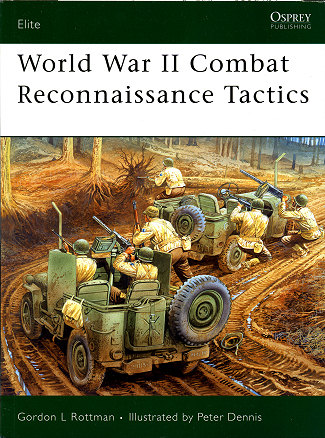 Continuing with
Osprey's excellent Elite series, this is another book that looks at tactics. In
this case, it explains and illustrates the techniques, equipment and unit
organization of the reconnaissance troops of the major WWII fighting powers.
Continuing with
Osprey's excellent Elite series, this is another book that looks at tactics. In
this case, it explains and illustrates the techniques, equipment and unit
organization of the reconnaissance troops of the major WWII fighting powers.|
Title: |
World War II Combat Reconnaissance Tactics |
| Author/Artists: | Gordon L. Rottman, illustrated by Peter Dennis |
|
Publisher/Distributor |
Osprey Publishing |
|
Price |
$17.95 MSRP |
|
Reviewer: |
|
| Notes: |
64 pages, 7¼ x 9¼ inches, softcover ISBN: 978-1-84603-137-3 |
 Continuing with
Osprey's excellent Elite series, this is another book that looks at tactics. In
this case, it explains and illustrates the techniques, equipment and unit
organization of the reconnaissance troops of the major WWII fighting powers.
Continuing with
Osprey's excellent Elite series, this is another book that looks at tactics. In
this case, it explains and illustrates the techniques, equipment and unit
organization of the reconnaissance troops of the major WWII fighting powers.
It is surprising to me that there would be so much difference in what seems to be a rather basic part of warfare. Reconnaissance is just as important to an army as supply, yet some nations, like Japan, seem to have often ignored it completely, while others, like the US, did not take the full time to properly implement it. By that, I mean that the willingness to sit and wait was not an American trait.
As much a result of equipment and terrain as anything, tactics used by the various sides were in many ways different. For example, there was little use of mechanization in the Pacific theater, where there were not good road systems nor open terrain. Both Japan and the Soviet Union suffered from very poor portable radios (if they had one at all), so had to have intelligence sent by runner or by the return of the reconnaissance units to base.
The British and Germans, on the other hand, seem to have made very good use of reconnaissance in both their planning and in battle conditions. Like the Americans, they made as much use of mechanization as they could, often having some pretty impressive firepower in their recce units. They had the willingness to be as stealthy as possible, trying not to let the other side know their recce troops were in the area. When trouble did arise, they generally had just enough firepower to disengage and get back with whatever intelligence they were able to acquire.
All of this is superbly written by the author G. Rottman and along with excellent period images and the artwork and maps of illustrator P. Dennis, makes this a book that is not only easy to follow, but one that adds much to ones knowledge of the subject. Another excellent Osprey book that I know you will enjoy reading.
September 2007
For more on the complete line of Osprey books, visit www.ospreypublishing.com. In the US, it is Osprey Direct at 44-02 23rd St, Suite 219, Long Island City, NY 11101., where you can get a catalogue of available books.
If you would like your product reviewed fairly and quickly by a site that has nearly 400,000 visitors a month, please contact me or see other details in the Note to Contributors.